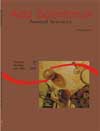<b>Daily and reproductive behavior of female crossbred (<em>Bos indicus</em> x <em>Bos taurus</em>) cattle bearing digital dermatitis</b> - DOI: 10.4025/actascianimsci.v31i2.499
Keywords:
cattle, hoof, foot disease, reproduction
Abstract
This present study aimed to evaluate aspects related to daily and reproductive behavior of female crossbred (Bos indicus x Bos taurus) cattle bearing digital dermatitis, raised semi-extensively, during 24 months. The animals were distributed in three groups (GI, GII, and GIII) with ten animals each. GI received cows bearing the erosive type of digital dermatitis, whilst GII received those of verroucous type and GIII received clinically healthy animals. Animals were observed during milking and grassing for daily and feeding behavior. Animal behavior was evaluated, whether standing or lying, as well as feeding period, frequency of water ingestion, rumination time and leisure. The reproductive behavior was studied as: service period, ovarian cyst presence, fetal envoltory retention, metritis, external signs of estrous, consistency of ovaries and uterus, number of services, pregnancy and birth. At the end of the study, it was possible to conclude that digital dermatitis, especially in verrucous presentations, do interfere negatively in daily behavior of female crossbred cattle. However, there was no evidence of differences in reproductive behavior among the evaluated groupsDownloads
Download data is not yet available.
Published
2009-08-11
How to Cite
Silva, L. A. F. da, Franco, L. G., Ferreira, A. R., Bernardes, K. M., Costa, A. C. da, & Rabelo, R. E. (2009). <b>Daily and reproductive behavior of female crossbred (<em>Bos indicus</em> x <em>Bos taurus</em>) cattle bearing digital dermatitis</b> - DOI: 10.4025/actascianimsci.v31i2.499. Acta Scientiarum. Animal Sciences, 31(2), 199-204. https://doi.org/10.4025/actascianimsci.v31i2.499
Issue
Section
Animal Breeding and Reproduction
DECLARATION OF ORIGINALITY AND COPYRIGHTS
- I Declare that current article is original and has not been submitted for publication, in part or in whole, to any other national or international journal.
The copyrights belong exclusively to the authors. Published content is licensed under Creative Commons Attribution 4.0 (CC BY 4.0) guidelines, which allows sharing (copy and distribution of the material in any medium or format) and adaptation (remix, transform, and build upon the material) for any purpose, even commercially, under the terms of attribution.
Read this link for further information on how to use CC BY 4.0 properly.
0.9
2019CiteScore
29th percentile
Powered by 








































